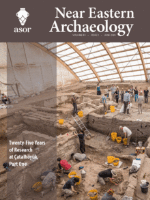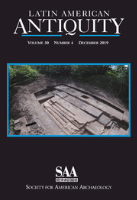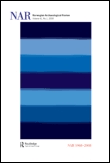
NEAR EASTERN ARCHAEOLOGY
Scope & Guideline
Pioneering Insights into Archaeology and History
Introduction
Aims and Scopes
- Archaeological Excavations and Discoveries:
The journal emphasizes original research stemming from archaeological excavations across the Near East, showcasing new findings that enhance our understanding of ancient societies. - Cultural Interactions and Societal Development:
A focus on the interplay between different cultures in the Near East, particularly the development of complex societies, trade networks, and cultural exchanges throughout history. - Environmental Archaeology:
Research addressing the relationship between ancient human populations and their environments, including studies on climate impacts, fauna, and agricultural practices. - Material Culture Studies:
Exploration of artifacts, including pottery, seals, and tools, to understand social structures, economic conditions, and cultural practices of ancient peoples. - Gender Studies in Archaeology:
Investigations into the roles of gender in ancient societies, as evidenced through artifacts and burial practices, contributing to broader discussions on social stratification. - Interdisciplinary Approaches:
The journal encourages methodologies that integrate archaeology with other disciplines such as history, anthropology, and digital humanities, fostering innovative research perspectives.
Trending and Emerging
- Human-Animal Interactions:
Increasing research on the ecological and cultural significance of human-animal relationships in ancient societies, reflecting broader concerns about environmental and ecological studies. - Climate Change and Archaeology:
A growing emphasis on how climate change has impacted past societies, including studies on resilience and adaptation strategies in response to environmental shifts. - Digital Archaeology and Visualization Techniques:
The incorporation of digital tools and methodologies for analysis and presentation of archaeological data, which enhances accessibility and engagement with broader audiences. - Social Identity and Gender Dynamics:
A rising focus on understanding social identity, including gender roles and expressions in ancient cultures, contributing to a more nuanced view of societal structures. - Cultural Heritage and Preservation:
An increasing attention to the importance of preserving archaeological sites and artifacts, particularly in light of modern threats such as conflict, development, and climate change. - Interdisciplinary Collaborations:
Enhanced collaborations across disciplines, integrating insights from anthropology, history, and environmental science to provide a more holistic view of ancient Near Eastern societies.
Declining or Waning
- Traditional Biblical Archaeology:
There appears to be a waning interest in purely biblical archaeology that focuses solely on scriptural narratives without integrating broader archaeological contexts or interdisciplinary approaches. - Static Interpretations of Artifacts:
Research that relies on static or uncritical interpretations of artifacts, without considering evolving methodologies or contemporary theoretical frameworks, is becoming less common. - Narrow Geographic Focus:
There has been a decline in studies that concentrate excessively on specific, often well-trodden sites, instead of exploring a wider range of lesser-known locations in the Near East. - Conventional Excavation Reports:
The journal has shifted away from publishing conventional excavation reports that lack comprehensive analysis and broader implications, favoring studies that provide deeper insights and contextualization.
Similar Journals

LATIN AMERICAN ANTIQUITY
Charting New Territories in Latin American Archaeological StudiesLATIN AMERICAN ANTIQUITY is a prestigious journal published by Cambridge University Press, focusing on the archaeology and history of Latin America. With an impressive impact factor reflecting its critical role in the academic community, this journal exemplifies excellence in research, landing in Q1 across multiple categories, including Archaeology and History, as per the 2023 category quartiles. The journal's scope covers a broad range of topics related to pre-Columbian cultures, ancient civilizations, and historical developments, making it essential reading for researchers, professionals, and students keen on exploring the rich tapestry of Latin American heritage. Although it is not an open-access publication, LATIN AMERICAN ANTIQUITY remains a vital resource for those dedicated to advancing knowledge in this dynamic field. With its commitment to scholarly rigor and a strong ranking in Scopus, it serves as a cornerstone for academic dialogue and investigation.

Intersecciones en Antropologia
Stimulating critical discussions in anthropology.Intersecciones en Antropologia, published by the Universidad Nacional del Centro de la Provincia de Buenos Aires (UNICEN), Facultad de Ciencias Sociales, is a premier open-access journal in the field of anthropology, having established its presence since 2010. With an impressive impact factor and currently holding the distinguished Q1 quartile ranking in anthropology for 2023, this journal has quickly become a vital resource for scholars and practitioners alike, offering a platform for innovative research and critical discussion. The journal aims to advance anthropological scholarship by encouraging the dissemination of diverse perspectives and stimulating dialogue across geographical and cultural boundaries. Its open-access model, adopted in 2017, ensures that valuable research findings are accessible to a global audience, fostering collaboration and engagement within the academic community and beyond. Located in the vibrant cultural context of Argentina, Intersecciones en Antropologia serves as a conduit for significant anthropological dialogues, making it an essential read for those dedicated to understanding and contributing to the evolving landscape of social sciences.

Norwegian Archaeological Review
Interdisciplinary Insights into Our AncestorsNorwegian Archaeological Review, published by Routledge Journals, Taylor & Francis Ltd, is a leading interdisciplinary journal that has made significant contributions to the field of archaeology since its inception in 1968. With an impressive Q1 ranking in the Arts and Humanities category for archaeology and an 86th percentile ranking in Scopus, this journal serves as a crucial platform for showcasing innovative research that advances our understanding of human history and cultural heritage. The Review provides a diverse range of scholarly articles, critical reviews, and thoughtful discussions, making it an essential resource for researchers, professionals, and students alike. While the journal currently does not offer an open-access option, it continues to maintain high editorial standards and relevance within the academic community, with publication converging up to 2024. The Norwegian Archaeological Review thrives as a nexus for academic discourse, encouraging the exploration of archaeological methodology, theory, and practice against the backdrop of contemporary global challenges.

Bulletin of the American Society of Overseas Research
Exploring the depths of archaeology and history for a richer tomorrow.Bulletin of the American Society of Overseas Research, published by the University of Chicago Press, serves as a premier platform for scholarly discourse in the fields of archaeology, cultural studies, and history. With its ISSN 2769-3600 and E-ISSN 2769-3589, this journal has swiftly established itself as a key resource for researchers, professionals, and students alike, demonstrating exceptional impact as evidenced by its Q1 rankings in multiple relevant categories for 2023. Notably, it holds the 93rd percentile rank in Arts and Humanities (History) and the 84th percentile in Social Sciences (Cultural Studies), evidencing its respected standing within the academic community. The journal's commitment to advancing knowledge and fostering interdisciplinary dialogue is complemented by its accessible publication from 2022 to 2024, making it an essential read for those engaged in the exploration of global cultural histories and archaeological research.

Adalya
Preserving History, One Article at a TimeAdalya, published by the esteemed Koc University Suna & Inan Kirac Research Center for Mediterranean Civilizations (AKMED), is a prominent academic journal dedicated to the fields of Archeology, History, and Conservation. With an ISSN of 1301-2746, this journal serves as an essential platform for scholars and researchers, fostering insightful discussions and disseminating significant findings about Mediterranean civilizations. Recognized in the quartile rankings of Q3 in Archeology and Q2 in both Conservation and History for the year 2023, Adalya reflects an impactful presence in its respective disciplines. Although it operates under a traditional subscription model, the journal remains accessible to a diverse audience interested in the nuanced exploration of historical contexts and conservation practices. Located in Antalya, Turkey, the journal has carved out a niche since its inception in 2009, bridging the past and present through rigorous academic inquiry. Whether you are a seasoned researcher or a student eager to deepen your understanding of Mediterranean cultures, Adalya offers invaluable resources and perspectives that enrich the academic community.

Azania-Archaeological Research in Africa
Advancing Knowledge in African Archaeology.Azania-Archaeological Research in Africa, published by Routledge Journals, Taylor & Francis Ltd, stands as a premier academic resource in the field of archaeology, specifically focusing on African archaeological research. With a remarkable tradition dating back to 1966, the journal spans over half a century of rigorous scholarship, aiming to enrich our understanding of Africa's diverse cultural and historical narratives. Currently indexed in the prestigious Q1 category for both Archaeology and Arts and Humanities, it ranks impressively in the Scopus database, placing within the top 12% of journals in its field. This commitment to excellence facilitates the dissemination of innovative and insightful research, catering to a broad audience of researchers, professionals, and students alike. While the journal is not open access, its impactful contributions continue to shape contemporary archaeological discourse, making it an essential resource for anyone passionate about the study of Africa's archaeological heritage.

Aula Orientalis
Illuminating History Through Rigorous ResearchAula Orientalis, an esteemed academic journal published by the Universitat de Barcelona's Institute of Ancient Near Eastern Studies, serves as a vital platform for scholarly discourse in the field of Near Eastern Archaeology, History, and Philology. With an ISSN of 0212-5730, this journal aims to disseminate high-quality research, fostering a deeper understanding of the ancient Near East through the publication of articles, reviews, and discussions by leading experts and emerging scholars alike. Although the journal has undergone changes in its indexing status, it continues to maintain a focus on rigorous academic standards and relevance in the global research community. Positioned at the crossroads of history and archaeology, Aula Orientalis encourages interdisciplinary collaboration and is ideal for researchers, professionals, and students seeking to expand their knowledge and engage with contemporary issues in ancient studies.

Bulletin de la Societe Prehistorique Francaise
Connecting Past and Present: Insights from Prehistoric StudiesBulletin de la Societe Prehistorique Francaise (ISSN: 0249-7638; E-ISSN: 1760-7361), published by the SOCIETE PREHISTORIQUE FRANCAISE, stands as a pivotal journal within the domain of archaeology, particularly emphasizing prehistoric studies. With its classification in the Q2 quartile of both the arts and humanities as well as social sciences in archaeology, the journal positions itself among the top 25% of publications in these categories as of 2023. This distinguished ranking reflects its significant contribution to the field, providing researchers, professionals, and students with critical insights and innovative methodologies related to prehistoric research. Although open access options are currently unavailable, the journal is committed to fostering academic discourse and sharing knowledge that influences contemporary archaeological practices. As a member of the elite academic community, Bulletin de la Societe Prehistorique Francaise is highly regarded for its rigorous peer-review process and dedication to the advancement of archaeology, making it an essential resource for anyone invested in understanding our historical roots.

Vjesnik Arheoloskog Muzeja u Zagrebu
Connecting Archaeology with the WorldVjesnik Arheoloskog Muzeja u Zagrebu, published by the ARHEOLOSKI MUZEJ & ZAGREBU, is a vital platform for disseminating scholarly research in the field of archaeology. With its Open Access model established in 2007, the journal ensures that vital archaeological findings and theories are accessible to a global audience, fostering greater collaboration and knowledge-sharing among researchers, professionals, and students. The journal is based in Croatia and has been an essential part of the academic landscape since its inception, with convergence noted in years such as 1979 and 1981, and continuing consistently from 2014 to 2023. While it currently holds a Q4 ranking in both the Arts and Humanities and Archaeology categories, its contributions to the understanding of archaeological heritage in the region are invaluable. Positioned within the 30th percentile among its peers in Scopus rankings, the journal endeavors to elevate the discourse around archaeological practices and findings, making it an important resource for anyone engaged in the pursuit of archaeological knowledge.

Studijne Zvesti Archeologickeho Ustavu Slovenskej Akademie Vied
Bridging the past and present in archaeological studies.Studijne Zvesti Archeologickeho Ustavu Slovenskej Akademie Vied is a leading journal in the field of archaeology, published by the SLOVENSKA AKAD VIED, ARCHEOLOGICKY USTAV, based in Nitra, Slovakia. This esteemed journal, with the ISSN 0560-2793, has established itself as a vital resource for scholars and researchers, reflecting significant academic contributions in both the arts and humanities as well as social sciences. With a 2023 Scopus ranking placing it in the second quartile (Q2) for archaeology, it showcases rigorous research and innovative methodologies, essential for advancing archaeological studies. While it is not an Open Access journal, it continues to offer valuable insights into archaeological findings, theoretical frameworks, and interdisciplinary approaches. The journal serves as a bridge, connecting local Slovak archaeology with international discourse, making it an indispensable tool for students, professionals, and academics striving for a deeper understanding of the archaeological heritage of Slovakia and beyond.